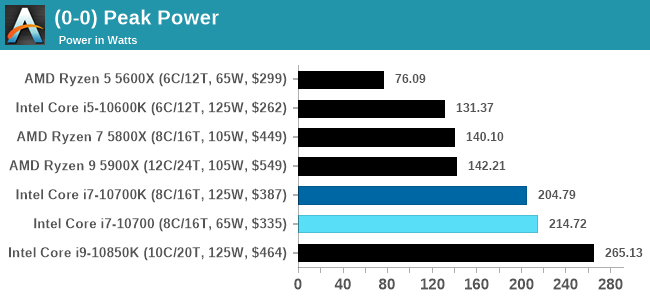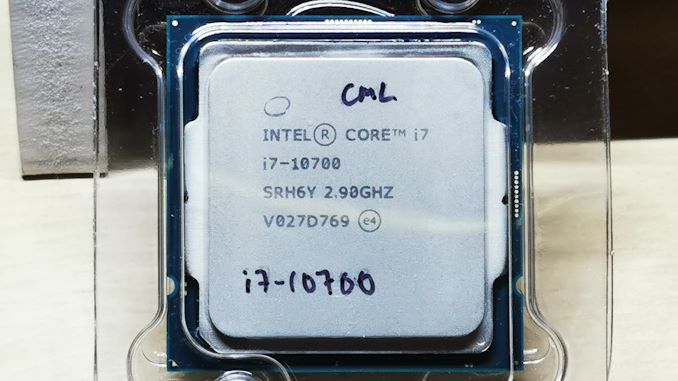Intel Core i7-10700 vs Core i7-10700K Review: Is 65W Comet Lake an Option?
by Dr. Ian Cutress on January 21, 2021 10:30 AM EST- Posted in
- CPUs
- Intel
- Core i7
- Z490
- 10th Gen Core
- Comet Lake
- i7-10700K
- i7-10700
Conclusion: TDP is Not Fit For Purpose
In years gone by, processors were sold with a single frequency and power rating. It was very quickly realized that if a processor could effectively go to sleep, using either lower voltage or lower frequency (or both) then a lot of idle power could be saved. Going the other way, processor designers realized that for temporary short bursts, a core could run at a higher frequency before it reached a thermal limit. Also, using a multi-core processor meant that either the power budget could be shared across all the cores, or it could be focused in one.
Both AMD and Intel have noticed this over time, and both companies have different attitudes on how they report numbers relating to ‘base frequency’ and related power as well as the bursty ‘turbo frequency’ and related power. Out of those four metrics, the only one Intel doesn’t provide is turbo power, because from their perspective it is system dependent.

Intel lets motherboard manufacturers determine how long a system can turbo for, and what that budget is. Intel encourages motherboard manufacturers to over-engineer the motherboards, not only for overclocking, but for non-overclockable CPUs to get the best performance for longer. This really messes up what the ‘default out-of-the-box performance’ should be if different motherboards give different values. The trend lately is that enthusiast motherboards enable an unlimited turbo budget, and the user building their system just has to deal with it.
This means that users who buy the Core i7-10700 in this review, despite the 65 W rating on the box, will have to cater for a system that will not only peak around 215 W, but sustain that 215 W during any extended high-performance load, such as rendering or compute. We really wished Intel put this 215 W value on the box to help end-users determine their cooling, as without sufficient guidance, users could be hitting thermal limits without even knowing why. At this point, 'Intel Recommended Values' for turbo time and budget mean nothing outside of Intel's own OEM partners building commercial systems.
Core i7-10700 vs Core i7-10700K Performance
In the review we highlighted that these two processors have a peak turbo frequency difference of 300 MHz and an all-core turbo frequency difference of 100 MHz. The fact that one is rated at 65 W and the other is rated at 125 W is inconsequential here, given that most end-user motherboards will simply enable turbo all the time. This means the performance in most of our tests between the two is practically identical, and consummate to a 100-300 MHz frequency difference.
In practically all of our tests, the Core i7-10700K is ahead by a super slim margin. At $387 for the 10700K compared to $335 for the 10700, the performance difference is not enough to warrant the $52 price difference between the two. Performance per dollar sides mostly with the Core i7-10700, although users getting the i7-10700K will likely look towards overclocking their processor to get the most out of it – that ultimately is what to pay for.
The other comparison point is with the Ryzen 5 5600X, which has two fewer cores but costs $299. In practically every test, the increased IPC of the Ryzen over Intel means that it sits identical with the Core i7 processors, AMD is cheaper on list price, and at a much lower power (AMD will peak around 76 W, compared to 215 W). AM4 motherboards are also abundant, while corresponding Intel motherboards are still expensive. The problem here however is that AMD is having such high demand for its product lines right now that finding one in stock might be difficult, and it probably won’t be at its recommended price.
Users in this price bracket have a tough choice – the more efficient AMD processor that might be in stock, compared to the Intel processor that will be in stock but more cooling will likely be required.











210 Comments
View All Comments
HarkPtooie - Saturday, January 30, 2021 - link
Noteworthy points:It is an i7-10700F
On a Gigabyte B460M
Populated with 4x16 GB DDR-3000
With an ancient Quadro K2000 and an NVMe SSD.
Hyperthreading is disabled.
I use it for running FEA simulations aside my Ryzen workstation, and it performs like a champ. The cheap&old wattmeter hoovers around 157 W or so during simulations. 100% CPU load.
So I take it that if I got the Z490, the CPU would draw 60W more. Would it go faster?
Qasar - Saturday, January 30, 2021 - link
as Spunjji said Harkptooie, practically every review out there, says the opposite of what you are.so, who is correct then ?
HarkPtooie - Sunday, January 31, 2021 - link
Oh, they do? Be a sport and link me to all those reviews.TechPowerUp puts it at 2W above the 3700X at stress test.
https://www.techpowerup.com/review/intel-core-i7-1...
Annnnd... that's it. The rest I find are all "compare" sites listing numbers culled from manufacturer sites.
And here comes Anandtech and tells me that my eyes are deceiving me and that my CPU is actually pulling twice as much as I am observing.
The explanation of which would be that better mobos have a power setting that allows it to draw much more than default, with no obvious benefits? I don't get it.
Everett F Sargent - Sunday, January 31, 2021 - link
Well, now you are almost there. Wherever there is. that is.Watts (power) * Time (seconds) = Energy (e. g. kWh) used
Power (W) versus frequency (Hz) is highly nonlinear (concave up and more so the closer you get to the redline). Your cooling solution can only dissipate so much power per unit time in 247 continuous operation, at a low enough core temperature.
This is all really basic stuff.
So, it will take longer to complete a fixed task at 125W then that same fixed task at 250W (all other things being equal), wherein the first task is running at 4GHz and the 2nd task is running at 5Ghz. These are only example numbers btw.
That TechPowerUp review has plenty of fixed task benchmarks (on the other pages) wherein the total time (in seconds) is given. You might want to check out those pages also.
They use four settings on a Z490 MB. The one that is closest to the out-of-box MB tests mentioned here is their "The third data point (blue bar) sees us relaxing the power limits to enable the maximum turbo frequency available for this processor." or what those bar charts are labeled as "Core i7-10700 Max Turbo" ...
It is a real shame that more sites don't do thorough enough reviews. So, for example, on this review on the 2nd page ...
https://images.anandtech.com/doci/16343/10700KInte...
That is a fixed time test and not a fixed task test. That should have been explained in this review.
Maybe this site will do better next time, by using a low end out-of-the-box MB in addition to their high end out-of-the-box Z490 MB. Report frequency, power, energy and time for all tests/tasks. Use proper recording of all these to get a more complete picture of what the heck is going on (time series and integrals thereof even).
My formal and informal (or on the job) training in doing scientific experiments goes back almost fifty years now. Not that that means anything on the internet. :/
Qasar - Sunday, January 31, 2021 - link
HarkPtooie toms hardware, gamers nexus, redgamingtech, moores law is dead. all pretty much say intel uses more power then amd. in some cases, quite a bit more.so either you have your system set up differently, and are forcing it to use the power it does, and the rest, let the board run as it see's fit, as you said : The explanation of which would be that better mobos have a power setting that allows it to draw much more than default, with no obvious benefits? I don't get it. " actually there is a benefit, when intel's cpus are allowed to use as much power as it can and wants, the performance goes up.
but what ever, you believe what you want.
HarkPtooie - Monday, February 1, 2021 - link
Yes, they do - but they do not say that the i7-10700 non-K uses twice the power of an equivalent Ryzen. That is exclusive to this article, and the explanation is that here they use "boost max all the time" BIOS settings that are not quite the nominal default for this CPU.This is overclocking.
Personally I turn it around and think "I am impressed at the performance Intel managed to squeeze out of this CPU at this power level, considering the process node disadvantage".
I am no fanboy. I usually buy AMD because bang/buck. This time I needed AVX-2 without having to tinker with experimental settings, which is the case with AMD+ANSYS.
HarkPtooie - Monday, February 1, 2021 - link
Ah - so the thing is that my CPU runs default as Intel intended it out of the box, whereas this review uses special motherboard settings that overdrives into a "use any power you need" zone where the max turbo runs all the time?Okay. That would explain things.
That Intel uses more power than AMD is not surprising since there is a substantial difference between 10 nm and 7 nm. And I am well aware that they cheat the numbers to look better - but that does not change the fact that nominally my 10700 draws about as much as my 3700X - and performs more or less equally. A bit faster single-thread, a bit slower multi-thread.
What this review amounts to is "If you reach inside your system and boost the shit out of your i7, it draws much more power than Ryzen." - why not go all the way and overclock them to 6 GHz and shriek about how the Intel draws 800W while the AMD only needs 600W?
Everett F Sargent - Monday, January 25, 2021 - link
What MB are you using and/or can you set PL!/PL2 in your BIOS settings? The article is suggesting that on higher end MB's, or some such, the PL1/PL2 settings are set to infinity or can be changed in the BIOS settings (even on a non-K CPU). PL1 is 125W so it appears that your MB has that limit.Everett F Sargent - Monday, January 25, 2021 - link
OK, made a mistake, the i7-10700 has a PL1 value of 65W and a PL2 of 224W and a PL1 Tau of 28s (those appear to be nominal or default values). Still curious as to the MB and accessible BIOS settings. Also is there any system software to see these settings (e. g. like AIDA64). TIAHarkPtooie - Tuesday, January 26, 2021 - link
I did not set any PL. The systems are default except for the RAM speed with is set by XMP to 3000 and 3200 MHz respectively.Should I interpret it as "during certain settings, the i7 can be made to consume vastly more power than it does by default"? That seems contrived.
All I know is that their power consumptions as measured for the whole system are roughly on par during conditions where incidentally the i7 also outperforms the Ryzen in single-thread applications. It is not a bad CPU.